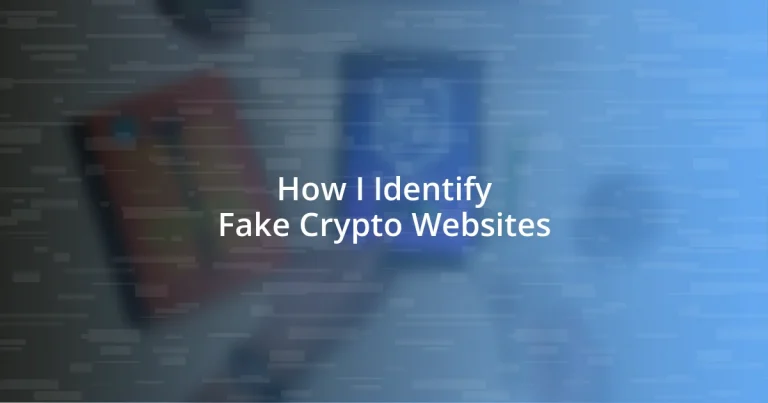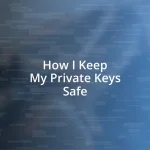Key takeaways:
- Watch for common signs of fraudulent sites, such as lack of contact information, unrealistic promises, and absence of security protocols like HTTPS.
- Check a website’s ownership and history using WHOIS lookup, and consider user reviews and community feedback to gauge credibility.
- Verify regulatory compliance and use scam detection tools to assess the reputation and safety of crypto platforms before investing.
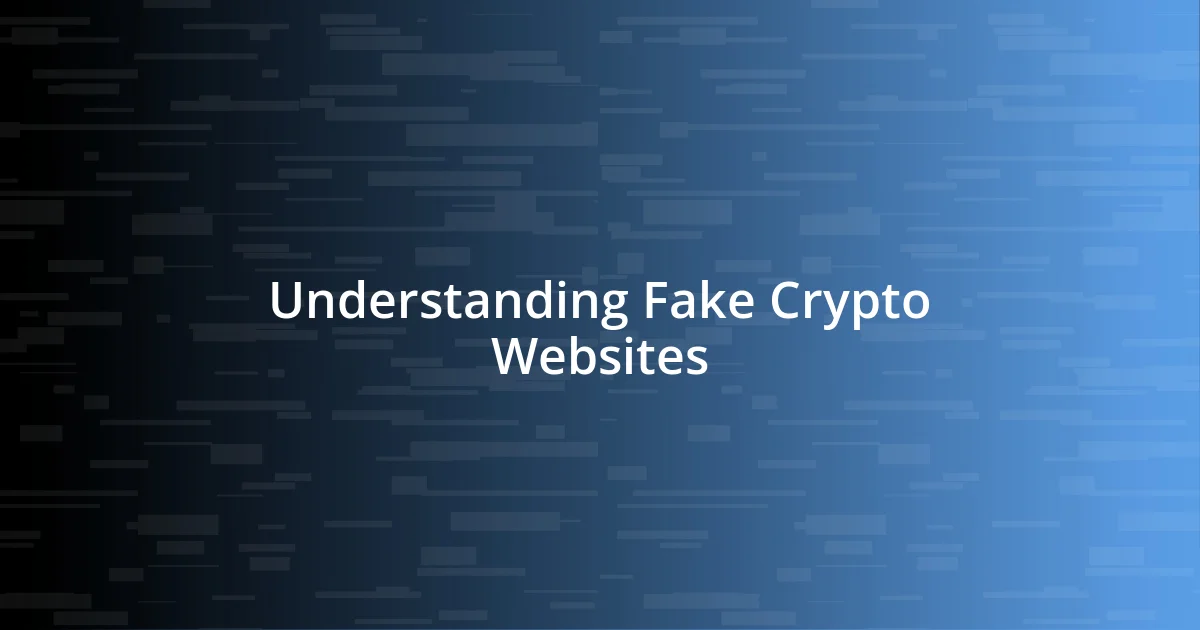
Understanding Fake Crypto Websites
Navigating the world of cryptocurrency can be daunting, especially when it comes to identifying fake crypto websites. I still remember the first time I stumbled upon a site that looked legitimate but was, in fact, a clever facade. It had all the bells and whistles, striking graphics, and seemingly authentic testimonials, which made me wonder—how can something so convincing be a scam?
Experience has taught me to pay close attention to details. For instance, I’ve encountered sites with glaring typos or odd phrasing that immediately raised red flags; after all, wouldn’t a legitimate site invest in quality communication? It’s a reminder that the presentation often reflects the authenticity behind the operation, which is why I trust my instincts when something feels “off.”
Another critical aspect to consider is the lack of transparency. I’ve been on sites that offer little to no information about the team behind the project. Whenever I see a platform with anonymous creators, I can’t help but ask—what are they hiding? Legitimate cryptocurrencies typically have verifiable team members, and knowing who’s behind an operation fosters a sense of trust.
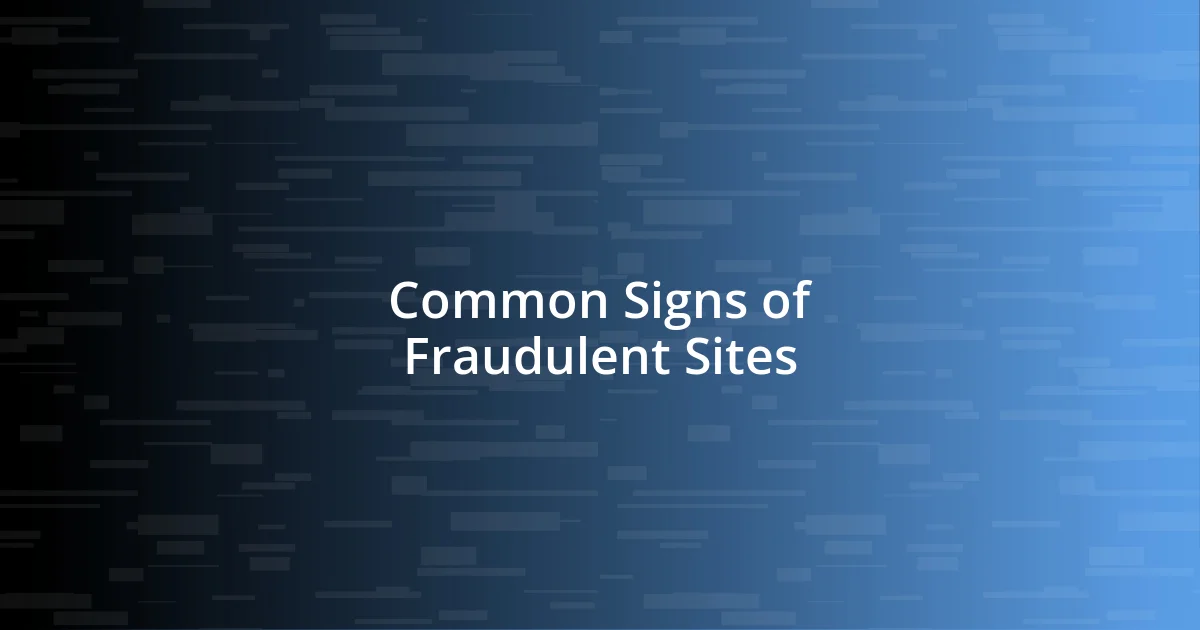
Common Signs of Fraudulent Sites
When I first started exploring crypto, I was drawn to flashy designs and promises of quick gains. However, I’ve learned that these can often be disguises for fraudulent sites. A common sign of deceit is a lack of contact information. If a site only offers a vague online form without any direct method to reach them, it’s a clear indicator that something’s not right. It makes me think back to when I hesitated to invest simply because the website didn’t provide a physical address or a customer service phone number. Trustworthiness in any business requires clear communication channels.
Another red flag is the presence of excessive hype and unrealistic guarantees. Scammers love to use phrases like “Guaranteed Returns!” or “Invest Now, Get Rich Quick!” I recall a site that promised to double my investment in a matter of days. It felt too good to be true, and sure enough, after some research, I discovered it had vanished shortly after my inquiry. This taught me the importance of skepticism—if a deal sounds too attractive, it probably is.
Lastly, always check for security features like HTTPS in the website URL. A site without this security protocol may not be protecting your data, which can lead to disastrous consequences. I can’t stress enough the feeling of safety that comes with knowing a site takes security seriously. When I see that small padlock in the URL bar, it reassures me that my information won’t easily fall into the wrong hands.
| Signs of Fraudulent Sites | What to Look For |
|---|---|
| Lack of Contact Information | No physical address or customer service phone number available |
| Unrealistic Promises | Claims of guaranteed returns or quick wealth |
| No Security Protocol (HTTPS) | Website does not have a padlock symbol in the URL |
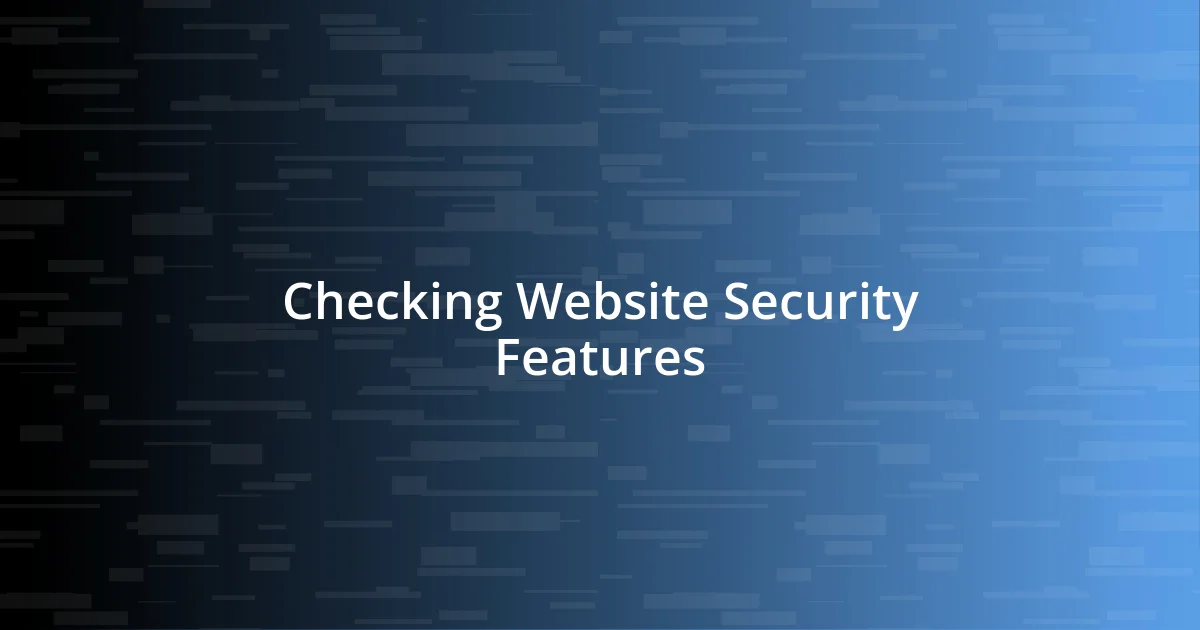
Checking Website Security Features
When it comes to checking website security features, I often find myself drawn to the small details that can make a significant difference. The first thing I look for is whether the website uses HTTPS. Many might overlook this, but having that ‘S’ at the end signifies that the site is encrypting your data. I recall visiting a trading platform once that didn’t use HTTPS. I could barely focus on the potential trades when the lack of encryption was gnawing at the back of my mind. It felt like walking into a bank without any security measures in place—just a hard pass for me.
- Look for HTTPS: A secure connection means better protection for your data.
- Check for a padlock icon in the URL bar: This small symbol brings a sense of security.
- Examine the website’s privacy policy: A legitimate site will provide transparent information on how they handle data.
- Find third-party security seals: Look for logos from trusted cybersecurity firms, as they indicate a level of safety.
The next feature I investigate is the presence of a visible privacy policy. If a website is serious about security, they will outline how they protect user information and what data is collected. I once made the mistake of registering on a site that had no privacy documentation. It was only after I started receiving sketchy emails that I realized they weren’t protecting my data at all. The experience left me frustrated and distrustful. Clear privacy policies not only reflect professionalism but also establish trust—an essential component in the world of cryptocurrencies.

Researching Website Ownership and History
When I delve into the ownership of a website, I often turn to tools like WHOIS lookup. This nifty service allows me to see who registered the site and when. I remember the time I discovered a suspicious platform during my research; the registration details were hidden behind a privacy shield. Instantly, it raised red flags for me. Why would a legitimate site want to hide its ownership? Transparency is key in the crypto world.
Examining a site’s history can also reveal a lot. I once stumbled upon a crypto website that had changed names multiple times. This pattern made me suspicious; it felt like they were trying to escape a poor reputation. Knowing the website’s history can help you gauge its credibility. Was it once associated with scams? If a site had a rocky past, I’d recommend proceeding with caution or even looking for alternatives. After all, why risk your hard-earned money on a company with a shaky track record?
It’s crucial to check reviews and discussions about the site on forums and social media. I recall encountering a site that appeared legitimate at first glance, but a few quick searches led me to online discussions filled with negative experiences from other users. The collective voice of the community became a guiding light for me. If others were voicing concerns, shouldn’t I listen? Engaging with the community made my journey into crypto much safer and more informed.
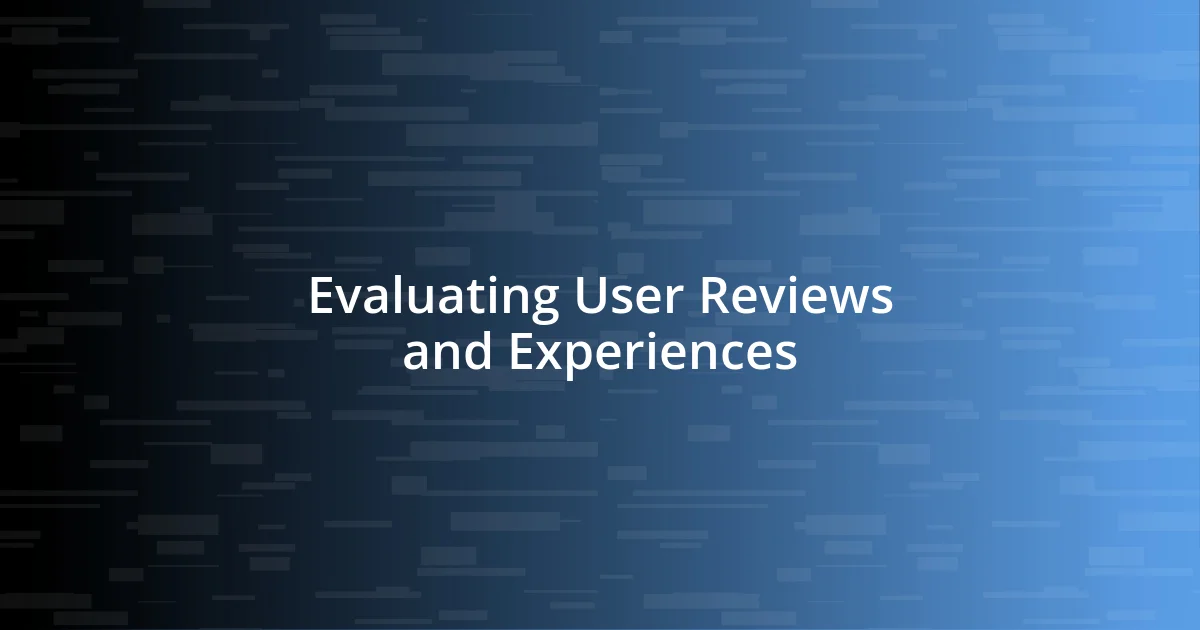
Evaluating User Reviews and Experiences
User reviews can be a treasure trove of information when evaluating a crypto website. I remember the first time I found a platform that promised high returns with minimal risk. Initially, I was intrigued, but a quick scan of user reviews unveiled a series of bitter complaints about payment delays and unresponsive customer service. It hit me hard; the excitement faded as I realized the importance of learning from the experiences of others. Has a negative review ever made you reconsider a decision?
Diving deeper into user experiences also shows you the emotional side of a platform’s reputation. I discovered this when a friend excitedly shared her experiences with a trading site, only for her story to take a turn when she faced issues withdrawing funds. Hearing her frustration made me think—how often do these hidden stories shape our understanding of these platforms? It made me appreciate the need to pay attention not just to the ratings, but the real-life experiences behind them.
Finally, don’t underestimate the power of social media forums and cryptocurrency communities. My latest exploration of a new exchange led me to insightful tweets and posts from seasoned traders. Their candid assessments painted a clearer picture than any flashy website could. Engaging with such communities definitely equips me with valuable knowledge. I often find myself asking, “What are others saying?” This curiosity has saved me from making costly mistakes countless times.
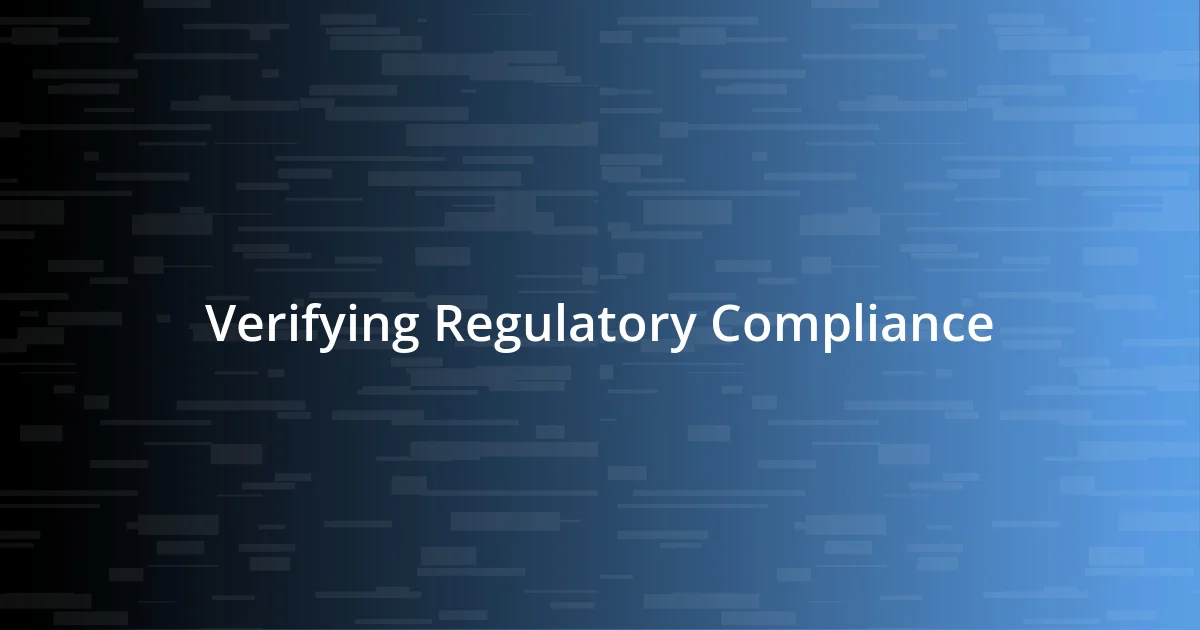
Verifying Regulatory Compliance
Regulatory compliance is a crucial factor I consider when assessing a crypto website. I often check if the platform is registered with relevant financial authorities. For instance, when I came across a promising exchange, I dug deeper and found out it lacked any regulatory oversight. How comforting is it to know your funds are protected by a governing body? The absence of such compliance usually signals that I should tread cautiously.
Apart from checking for registrations, I also look for transparency in how a platform operates. One time, while exploring an ICO (Initial Coin Offering), I noticed they boasted about their regulatory compliance, but a quick glance at their terms revealed vague language and loopholes. It made me question their sincerity. If a site is genuine, shouldn’t they make their regulatory status clear and easy to understand?
Another essential component is understanding the jurisdiction of the website. Certain regions have stringent regulations, while others are more lenient. I remember being drawn to a site seemingly compliant with a well-respected jurisdiction, only to discover it was operating under lax regulations in another country. This discrepancy raised concerns about their accountability. Would you trust a platform that could easily evade regulation? I know I wouldn’t.
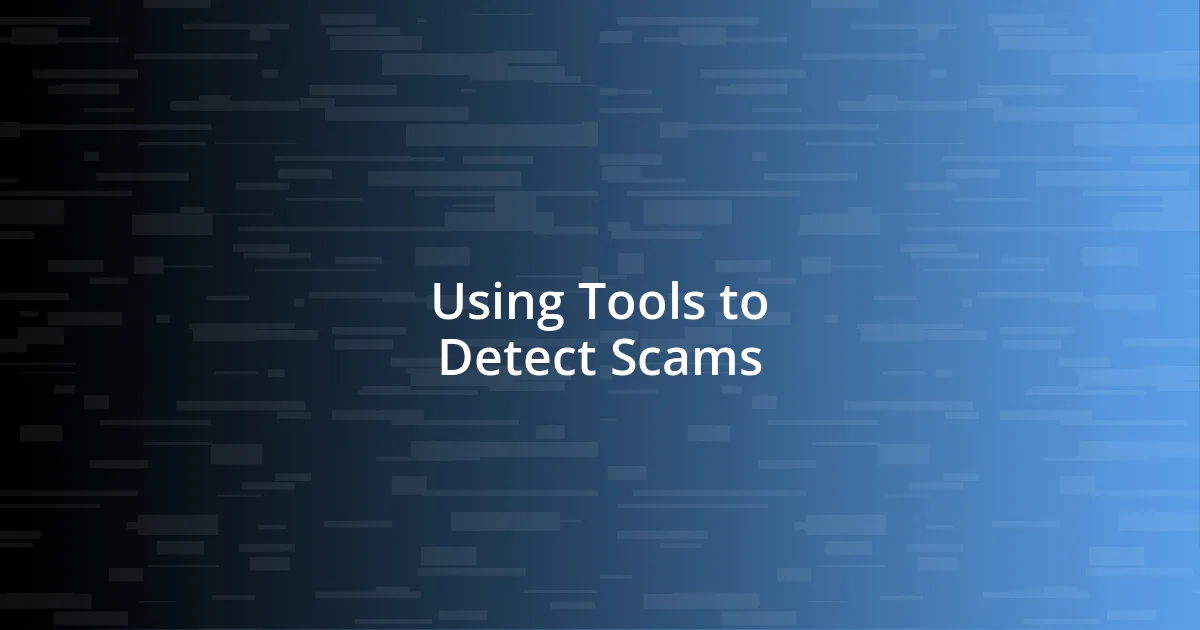
Using Tools to Detect Scams
In my experience, utilizing scam detection tools can make a significant difference when assessing crypto websites. I often turn to online services like ScamAdvisor or Trustpilot to gauge the reputation of a platform quickly. Just the other day, I tried to compare two exchanges, and the stark contrast in their ratings opened my eyes to potential pitfalls.
I recall a time when a friend excitedly introduced me to a new crypto platform boasting cutting-edge technology. However, a simple search on a scam detection site revealed it had numerous red flags—like a low trust score and numerous negative reports from users. Was it worth the risk? That moment taught me the value of using these tools as part of my decision-making process.
Moreover, browser extensions that flag suspicious sites have become my best friends. They pop up warnings when I visit a sketchy website, allowing me to rethink my actions in real-time. I can’t stress enough how much safer I feel knowing that there’s an extra layer of protection while I navigate this vast digital landscape. How often do we disregard those little warnings, only to regret it later? From my perspective, those tools are not just nice to have—they’re essential in the crypto world.












